Level design and gameplay roguelike on the example of Cogmind
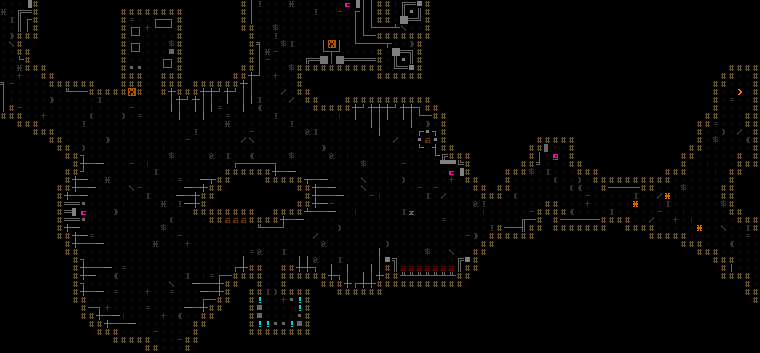
For many years, I used a fairly standardized approach to the design of each new Cogmind card, and although now there are dozens of them, I have never considered it in my blog. This is mainly due to the fact that a detailed analysis of the whole process will require disclosure of a heap of content, because all the most interesting maps are located after the first stages of the game.
But after the recent release of Beta 8 , which added a very interesting map at the very beginning of the game, we had a great opportunity to discuss the design of the cards, not really worrying about spoilers, then basically this content is quite easy to find.
In this article I will walk through all the stages of the design and implementation process, from beginning to end. In the process of creating Beta 8, I made a lot of notes about the process itself, especially in order to share them with readers and give a clear picture of what is happening.
')
Note that unlike most Cogmind maps, because of its nature, this particular map has mostly static layout and content, and it does not actively use procedural methods. Therefore, in the process some stages are missing, but I will discuss them in a separate article. On the other hand, for the most part, a static map in itself provides unique analysis capabilities.
Idea
Before starting work on each map, it is necessary to come up with one or several concepts on which the map will be built, and in this case we had several goals:
- add more potential variation, especially early in the game
- create more elements that draw to the story at the beginning of the game
- help new players
For a very long time, my notes on the possible elements of Cogmind contained the concept of “abandoned laboratories” - a way to get access to a strange and curious technology, so when I felt that I needed a new gaming area to achieve all of these goals, I thought that this concept was very for her is suitable.
As soon as I decided that I would most likely do this (several months before the implementation itself), I began to review this part of the notes from time to time and supplement them with new ideas and reasoning. With each new addition of new ideas, I deliberately avoided re-reading previous notes on this topic, but simply added new thoughts below. This allowed me to keep a unique way of thinking, which helped me to come up with potentially very diverse ideas or even the same ideas, even without realizing it (it happened because days and even weeks passed and I forgot the details of my previous ideas). It is worth noting that randomly repeating notes about the same ideas can actually be valuable, because they reinforce these ideas, sometimes with different justifications, or even send them in different directions, which I did not think of in the previous notes!
This process led to the writing of approximately 2,600 words of rough notes on this topic, which, like all my notes, are arranged as nested lists in a TXT file.

All draft notes about the new map in my text editor.
I usually just delete the draft notes when I implement their contents or convert them to more decorated notes elsewhere, but this time I decided to save them to share with you. Download / read my original notes here (for correct display you need to disable line wrapping!). Since note taking is a top-down process, you may notice that with each addition, they become longer and longer, because I obviously went back and forth at different times. They even have a “final result”, followed by, as usual “final final notes”, followed by a note “no, wait, the final final notes contradict this”.
If we describe the idea briefly, the new gaming mini-faction called “Exiles” from another society of robots has its own laboratory, which gives the player a new sensory ability (called FarCom) and access to equipment prototypes from a pool of possible items. From the point of view of the plot, this faction becomes the very first acquaintance of a player with the lore of the world. So it's good that I returned to adding this map after completing the rest of the world, because it can be properly combined with my knowledge of how the game should be played in terms of plot and gameplay. If I did the opposite and tried to create this map from the very beginning, then I most likely would have to repeatedly update or change its content in the process of building the rest of the world. (The world of Cogmind was almost completely built from beginning to end, without jumping back and forth.) I am not a fan of cutting out old content and making major changes to it; I try to do everything right the first time.
Therefore, at the end of October, when it was time to add Exiles, my first task was to organize these draft notes. This usually means that you need to re-read them and get rid of stupid ideas, make them more holistic and clarify the not completely understandable points, making it so that everything fits together and reinforces my vision of this card.
However, I didn’t spend too much time on this phase, then that this time there were too many notes, and more importantly, after a while they would still be transformed into a new look. After removing a few optional fragments and making small changes, I quickly set about creating this design map document.
Design document card
The final planning step before starting to work on the map is to bring all relevant records into a simple format that I have used since the beginning of Cogmind Alpha.
In general, each card has its own text file with a description of its design. I call these text files "applications" because their idea came when I started using these external files as attachments to the original Cogmind dizdok, a huge file that by the time the first public alpha was released, two years later, it had become a bit cumbersome ( I didn’t like the program and format that I used to create the original dizdoc, and I wanted to start moving away from it, because by that time the entire original design document was already implemented).
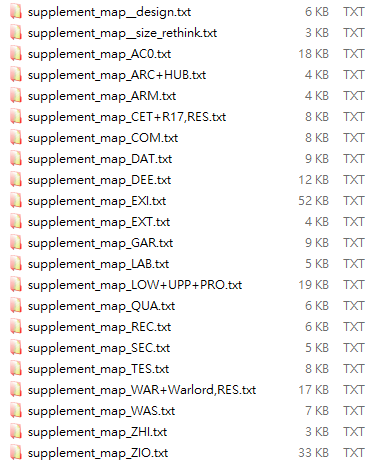
Applications to different cards added over the years. EXI is the Exiles designation; compare its size with other files. It turned out to be one of the most difficult maps, with a bunch of possible content and various scenarios.
The design documents of the cards divide their contents into several standard sections, in which at least the following are presented:
- purpose: the main purpose of adding a card
- scheme: a brief description of environmental factors, including topography and items that the player will see
- inhabitants: descriptions of all enemies (in the case of Cogmind these are robots), which can be found on the map
- gameplay: basic interactive map elements, including all causes and effects associated with dynamic content
This is the main four sections, but some cards have one or two additional categories of notes applicable to a particular map. For example, in the design document of the Exiles map, a “location” section was added, because unlike most maps, there are many important comments about how to get to this map and its general location in the world. It also has a large section on the “concept of parts” for gathering ideas about recruiting equipment prototypes.
The entire Exiles map design document can be read here (here, too, it is worth disabling line wrapping). If you read the link above drafts notes. then you can see how they evolved into a real design document, which has increased in size three times (there are about 7,500 words). Some minor details of this document may differ from the finished implementation, because I sometimes make changes at the last moment, and they are not always reflected in the notes; but for the most part they are accurate.
High level design
It is extremely important to extend the initial process of creating a card design to include a vision beyond the card itself . It is necessary to determine in advance how the card corresponds to the overall picture regarding the player’s strategy, because it can have a serious impact on the content of the card, and if you are not careful, a poorly crafted card may require significant new changes as a result if players decide that it is or not too interesting, or of little use to them for the long term. *
(* Now in Cogmind there is one side map that, unfortunately, fits this definition: Recycling. This is a fairly simple and small map that has its own unique mechanics, but its advantages are not as attractive to players as I originally saw it when I I created it in the early stages of Cogmind Alpha. At that time, I was just starting to add side maps and since then I learned a lot, including from the gradually mature game community. I have plans to improve it, but this is not a priority until version 1.0, because she is d freely away from the main road.)
I did not want to spend my time and players time, so the Exiles card in particular has implications for a long-term strategy, and in order to integrate it correctly into the overall gameplay, it was necessary to take into account the various needs, goals and tricks of the players.
As with almost all of the additional Cogmind branching world maps, Exiles offers its trade-offs, simplifying some game areas, while at the same time increasing complexity.
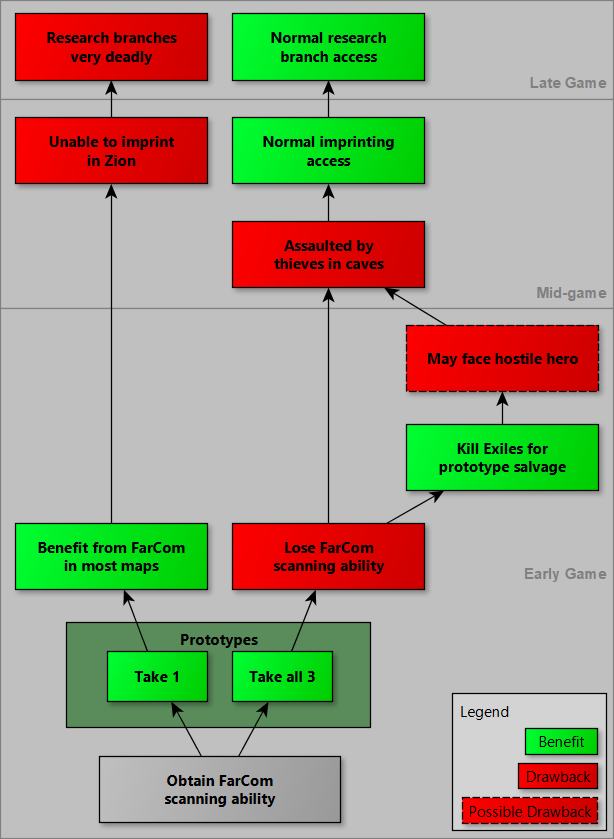
Major decisions on long-term strategies related to Exiles. Note that some of the “flaws” may seem good to one player (or at least neutral), so this graph can be interpreted differently. (I chose the most standard look.)
There are other random Exiles scripts that may affect the available choices, but here I will only look at the most common ones. In addition, the graph above shows only the most important strategic decisions - individual prototypes can change a player’s potential route or even incline him to certain character configurations, because they are randomly selected from the pool of options. In general, this single card actually opened up many new choices! I will tell about these options below.
As planned, the standard benefits provided by the Exiles card (one free prototype + FarCom) are particularly noteworthy in the short term, but have short-range flaws, therefore they are an excellent choice for new or inexperienced players. I do not want to say that they can not be useful for experienced players as well - one of the users has already reached very far thanks to the use of FarCom, which essentially does not allow the use of Research branches in the later stages of the game, even though the player usually gets access to the most effective tools to cope with the vast complexities of the game.
Thanks to the tradeoffs, visiting the Exiles becomes much more interesting; in fact, they are necessary, because without compromise a player could easily become too powerful, and without hesitation, he laid a route through this map. Naturally, such obvious flaws do not necessarily appear on every card, because in many cases the disadvantage is the inherent price of the player receiving items or battling those on this card. But here I must emphasize that all the inhabitants of this card are friendly to the player, and getting to it is quite simple, therefore, more stringent measures were required.
Well, okay, planning is finished, for now, to start implementation .
Building blocks
We have already conducted a high-level analysis and we already have sufficiently detailed plans that can be used to guide us when building a new map. The first step will be the manufacture of all entities and objects, that is, in fact, any object that can be created separately. We use the “first pieces, then the puzzle” approach: we will break the big project into the smallest parts and first work on each of them.
But at this stage I don’t even add them to the new map - it does not exist yet.
Since such a huge amount of content requires a lot of work, adding each new element to the map often requires thinking at several levels (local, map scale, scale of the whole game), which is much less effective than focusing on as few aspects as possible without the need for constant return back. Effective work is not only faster, but also improves the results.
So, the plan is to create all the fragments, and then simultaneously connect them.
Personally, I prefer to start with fragments that require the most time to implement. The most important thing in the list of such elements is that which seems to me curious or interesting, but in the end is “optional”: rare special events, objects, etc.
A lot of time is spent on things like the time-traveling object Chronowheel from Beta 8. This is one of those things that I think about: “so, today I will do it,” and at the end of the day: “so, you will have to finish it tomorrow,” and then, after a couple more days: “yes, it’s already time to finish it today "(And sometimes this still can not be achieved).
But it is precisely this kind of content that makes the project what it really is: a world created with love, and not just “a game that needs to be sold in order to make ends meet.” If you leave these complex unnecessary things at the end of the release cycle, then the likelihood that you have to give up is greatly increased: I see that the deadline is on the nose and there are many more essential tasks, not to mention fatigue, which accumulates by the end of the cycle.
In the end, I always find myself satisfied with what I did with these parts of the content, but I need to force myself to plan correctly to achieve this.
Subjects
Items are minimal card building blocks, so we’ll start with them.
Initially, in notes and design documents, they are listed in a completely random order, but for the sake of efficiency, I ordered the list to combine them into categories. For example, all types of weapon-firing weapons must be created in order, because they will use similar pieces of data and code. This makes the list work more natural, without having to jump between different areas of code / data and increase the mental scale of the work.
However, before proceeding with the code or data, I worked on a completely different area: graphics. All art for new items (there are more than 30) was created in a few days, because, I repeat, it makes sense to perform similar tasks in a crowd. It may be more difficult to withstand when such a process stretches for several weeks or more, but for a lone developer who, despite the long process of developing a game, can perform only one task at a time, efficiency becomes very important.
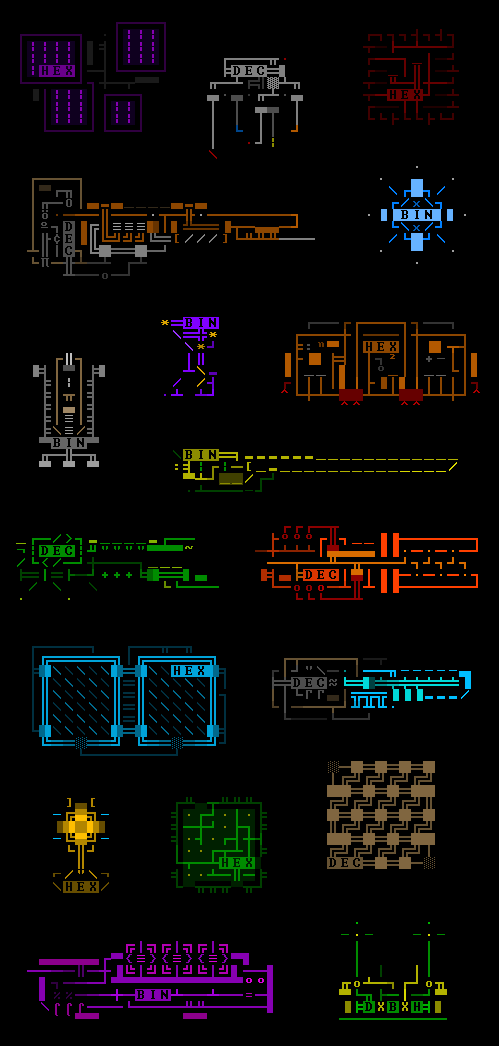
Art of some prototypes of EX-technologies from Beta 8. Each of the new main NPCs that I planned for the new map “signed” its own prototype with its own name.
Immediately after the art I took up the lore. With each of the new items associated text Lora. Seeing that in some cases it allows you to define or improve the characteristics of the subject, I wanted to ensure the accuracy and integrity of all texts. Therefore, all these fragments were written at a time, and this is important: it is assumed that the player will detect and read them in a certain order.
Finally, it was time to create dozens of items directly - adding data, balancing their characteristics, and so on, which generally took a couple of weeks. For some items it could even take as little as 30 minutes or so, while for others, for example, the above-mentioned Chronowheel, it took several days.
The “Latent Energy Streamer” (LES) weapon adds a completely new resource called “latent energy” (latent energy), which can potentially be used further in the future, but so far it has been added only for a single weapon, although it took several days to implement it.
Hidden energy can be found on the map, and more often it is concentrated next to stationary elements of the entourage like cars and doors.

Activation of the LES, which also detects hidden energy nearby.
LES attracts this energy and focuses it, creating a destructive amount of electromagnetic damage, but it has a side effect: the weapon destabilizes explosive machines in the vicinity, breaks automatic doors and even hurts its owner. In fact, many Exiles prototypes have negative side effects, so you can give the player such powerful details in the early stages of the game.

LES shot. It took some time to improve the animation of the shot, it differs from firing from conventional weapons in that it is more connected with the environment - it draws lines to the latent energy, which is used for the shot.
LES itself has a unique label that indicates the amount of energy available nearby, and also shows the damage interval into which this energy can be converted. These values change with natural fluctuations of the local energy, as well as with its application and slow recovery.
I am very pleased that LES appeared in the game (and I can’t wait to see when I can use it myself during the normal course), but if I had postponed its implementation in the development cycle for later, I’m not sure that it happened.
NPC
There is another building block behind the items: the NPC. Some of these bots use new items, so they could not be created earlier, but now items are ready, and we have everything we need to build bots. An entity (robot) is a fairly self-sufficient small development unit, independent of the card itself (but which will become part of it), therefore it is a good candidate for early creation. Building and balancing the bots took some time, but since I was able to focus exclusively on them, in the future it will be easier to place all of them on the map.
There are four important new NPCs on the Exiles map, each of which has a data set that defines their properties. And this is a rather large set!

Here is an example of data from one of the new NPC named 8R-AWN. (I broke the data line a couple so that you don't have to scroll it for too long.)
After completing the creation of their data, I passed them through a separate program that can analyze the design of robots and report whether they will have excess mass, problems with resources, overheating in battle, and other problems. Their characteristics can be changed if necessary, and only then finally go to the map itself .
Although not really ... At this stage, I decided that before proceeding with the map, I would implement the sensory ability of FarCom, which can be given to the player by NPC. You can also work on it as an isolated system, because I test it in detail, and not immediately develop a suitable way to get the sensor in the game. Like a puzzle piece, you can attach it later.

FarCom in action: it demonstrates a dim circle in which hostile bots 0b10 are found. (The circle pulses weakly, but in gif it is not very noticeable.)
In terms of overall design, there are so many differences between FarCom and conventional attachable sensors that there is no obvious preferred detection method for all situations. Each has its advantages and disadvantages.

Comparison of standard sensors and FarCom. Green cells - positive properties, red - negative.
However, FarCom is obviously a blessing for beginners who receive a free way to detect threats at a distance without having to use any items for this knowledge. It is difficult for novice players to find sensors (and understand how to use them!), Moreover, the details, unlike FarCom, can be destroyed.
Without a doubt, the most significant advantage of FarCom, which is very attractive for experienced players, is that it does not take a single slot of parts. This is especially true in the early stages of the game, when two slots are quite a large part of the free Cogmind slots. Players using sensors try to do with one slot (only an array of sensors without an interpreter), but in order to obtain the same level of detail as FarCom, it is necessary to allocate two slots for sensor data.
One or two vacated slots means that you can hang more armor on the robot, more storage space, improve aiming and / or use any number of other auxiliary options, and this advantage extends to the entire process of passing where FarCom is active. Of course, FarCom is still not the subject that everyone seeks to take possession of: the table shown above shows that it has serious drawbacks in the later stages of the game.
In general, I am very pleased with how everything turned out.
Scheme and integration
It's time to create a map! Well, or something like that ...
I always start with empty sheets of paper, because it seems to me the most natural, fast and free way to work.
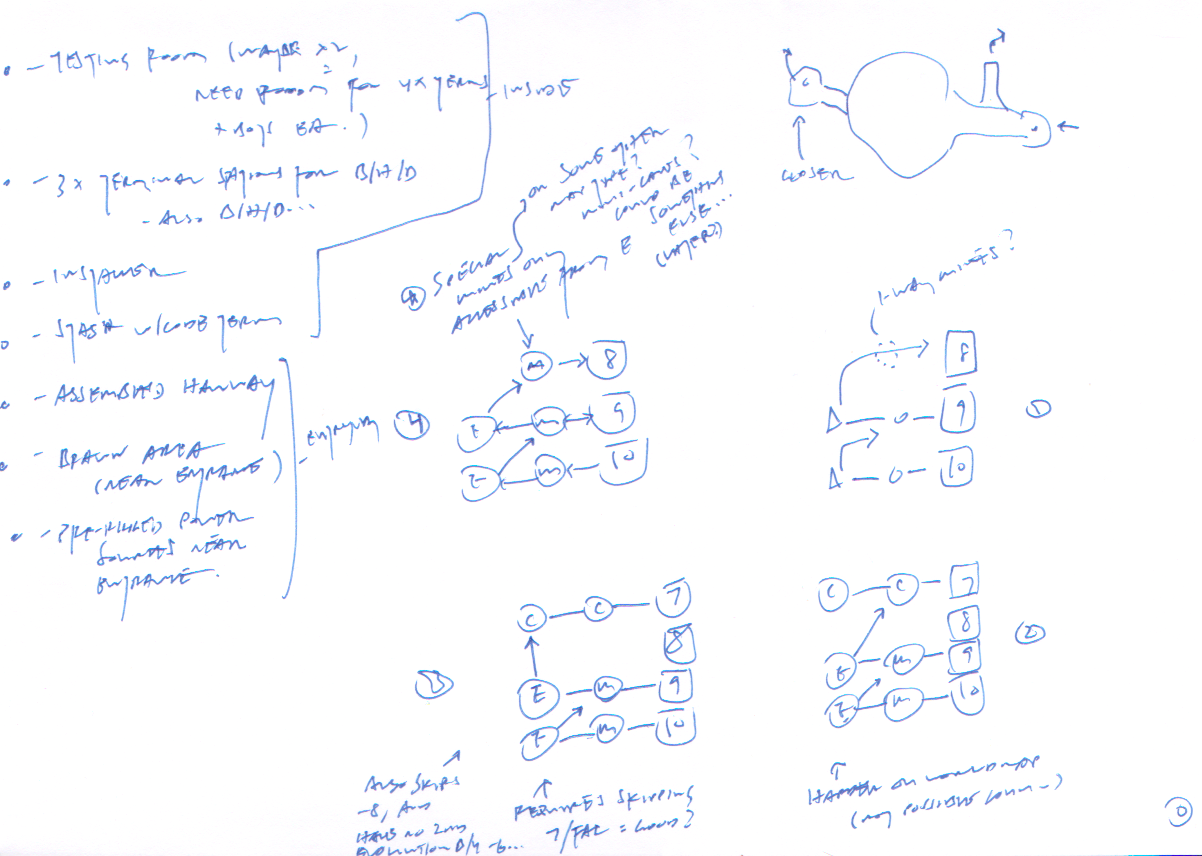
Planning of the general scheme, content and communication with the world of Exiles card.
The main part of this page is occupied by graphs linking this new map with the rest of the world. The route that a player needs to go through to get on this map and return to other areas are important factors that determine rewards and difficulty levels.
The Exiles card is available either from a depth of -10 (in fact, the lowest level!), Or from -9; By the way, at the same depth is Mines. However, if they appear only at the same depth, then the entrance is hidden inside the Mines; therefore, I have added a special indicator that allows observant players to find out if they are at the same depth as Exiles. I didn’t want the players to waste their time, bypassing the entire depth of the Mines in search of the entrance that might not be there, so I added the so-called “ level sensations ” - the mechanics used in many classic roguelike, for example, in NetHack , ADOM and Angband , in which, when you hit a new card, you get a log message, reflecting a particular aspect of this card.

The first example of using Cogmind is “level sensations”; added to save players time when searching for Exiles.
Players can also read the ENOR terminals, which explains the scan.
As for the way back after visiting Exiles, I thought it might be worthwhile to send the player back to the main path through Lower Caves, but that was when I was still trying to limit the design to the options already available. But as a result, I decided to add a new depth of Mines to -8, which can be achieved only by returning from Exiles. This improves the gameplay (Mines are the smallest and simplest cards suitable for weak players), and more logically (it should not seem that Exiles are too close to the Complex, so the poet cannot directly return to it from this map).

In-game map of the world showing the route of the player who visited Exiles and returns to -8 / Materials via -8 / Mines. This depth of Mines is usually not directly available in the opposite direction from -8 / Materials to avoid adding unnecessary outlets to this map.
A small shapeless fragment in the upper right corner of a paper draft is actually quite important; it defines the general input / output locations for the card itself, which, in turn, can influence the design of the entire map (topography scheme, content layout, event timings ... ). These most important points determine the flow of gameplay. The player enters from the bottom right corner, and almost immediately the connection leads to the exit to the outside (mainly necessary to give other robots a way to enter the map from this side - I'll tell you more about this later), the main content area will be in the middle, and further to the left there is a second “rear exit” from the map.
Finally, in the left part of the notes there is a list of ideas for things that need to be added to the map of the card itself, a sketch of which I will do in the next step.
* I am left-handed, so I usually place the paper horizontally and fill the pages with notes from right to left.
Having worked the connections, we must proceed to the creation of a more detailed sketch of the map scheme!

The first version of the reference sketch for the circuit map Exiles.
This is a static map, where there are interactions with important NPCs, so the scheme should take into account the process of passing a new player, falling on it for the first time - what will he see first and what will he think that the order of passage makes sense?
So, having executed the short preliminary sketch shown above (based on the previous general list), I had to pause and go directly to the content, in particular, to the dialogues. Yes, the NPCs are not yet located on the map, and the map itself is not there yet, but by writing the dialogs in advance, I can make sure that no NPC says too much. Otherwise, you would have to transfer some lines to others, which could affect the map scheme (and affected).
Having finished with the dialogues, I made another pass through the map design, creating a second, more specific iteration corresponding to the dialogs:

The second iteration of the reference sketch map Exiles.
The player enters the map from the bottom right corner, sees another corridor leading to the exit, but there are no enemies nearby, so you can safely continue your research. In addition, in the tunnel in front of the player there are several "fake" power sources - this mechanic was only possible thanks to Exiles technology, and therefore will be new to the player. Curious players may want to study them, and then continue exploring the map, first meeting 8R-AWN in the hallway with a welcome speech / introduction. The players then move to the central area and find the second important NPC, EX-HEX, who sets out a little more lora and suggests finding an EX-BIN to help with the project. After that, the player can move anywhere: either learn more about this place from the NPC prototype testers in the southern region, or head north,To get the main bonuses of this card - FarCom and prototypes. Both directions are quite suitable for the first passage. The player can then exit the card by turning back to the east side, or, most likely, passing through the back exit.
At this stage, I moved on: I created all the additional lore from the terminals and dialogues with unimportant NPCs, because there could be something in them that could also affect the map scheme (in fact, the scheme did not change, but no matter what Dialogues have become a good way to keep up the pace of work, while still being in “script mode” - this is it, efficiency!).
Then it's time to use my next tool: REXPaint . I turned the reference sketch into REXPaint into a general scheme, measuring the distances between the cells so that everything fits correctly, is not too compressed or too spacious, and that the area of visibility of the average player from any point opens the required amount of content.

The Exiles map takes form in REXPaint. So far this is just a single layer containing the general scheme, the entrance and the exits, but without objects and other details. Also, there are no specific details of the scheme that may arise / become necessary after adding objects.
And after saving this file, you can already add it to the game!
(This card has a completely static scheme, so it skips some steps that many other cards may require. For more information, see the appendix.)
Content
Now it's time to build the gameplay itself, starting ... beyond the map.
This is a newbie friendly map located outside the main track, so I wanted to add a few ways to push new players in this direction. Therefore, before starting work on the card itself, I again decided to develop the passing process, starting with how the players will most likely find it for the first time. The 8R-AWN robot, which is the exiles “brains” executor, is the first person the player encounters when visiting their laboratory / cave, sometimes performs tasks for the “brains”, and the player may encounter him on other maps when he performs these tasks .
At one of the first Materials levels, the corresponding Exiles depth, 8R-AWN can be found paving the way to the exit from Mines. The chance of finding him there is higher for new players who have never seen Exiles before (unless they used seed, because the seed-generated content must be constant and independent of the player’s history). Having noticed the player, 8R-AWN invites him to follow him, and continues to destroy hostile robots along the entire route until the exit. (Or if the player was in the back of the map, he can simply find a path from the destroyed robots when 8R-AWN left the map a long time ago.) The robot will get to the exit, and if he spoke to the player earlier, he will wait until the player will arrive, after which another dialogue will begin and the robot will continue to lead it to the hidden entrance to Exiles.
Another possible encounter with the 8R-AWN occurs during the invasion of the Mines. The sudden attack of the Assembled swarm is a pretty bad situation for an unprepared player, so it's good that 8R-AWN can appear here and save the situation, using special technology to turn them off remotely. In this case, if he sees a player, he will also lead him to a hidden entrance.
In fact, it took several attempts to create the design of this hidden entrance. The wall was supposed to open automatically in front of a friendly player, but I didn’t want the player to see it from afar, considered it a dead end, never approaching it. Therefore, the trigger was located in such a way that the walls opened as soon as they came into view of the player.

Exiles entrance design on Mines map. From the player’s point of view, it seems that the corridor continues until it turns the corner, after which the hidden doors open automatically, provided the player is friendly.
This input is arranged as a guaranteed billet using the method before generating the map described here .
Exiles
In the same post, the link above describes the methods for creating data / scripts that define the content of Exiles, which is a static map from one giant workpiece.
At this stage, we can begin to place all the objects created earlier - objects, NPCs, dialogues, ENTs, etc. Therefore, this is a fairly fast process, because all the objects are ready. This is better than constantly stopping for their gradual implementation. Instead, I can now focus on their location at the macro level, and not worry about low-level details.
We again follow the flow of passing, going to the map on the right, only this time we use additional layers of REXPaint to draw the machines (gray lines) and mark the positions of entities and objects (green letters and green numbers). Cars and other objects of the entourage, including invisible triggers, are marked with green letters in upper case.
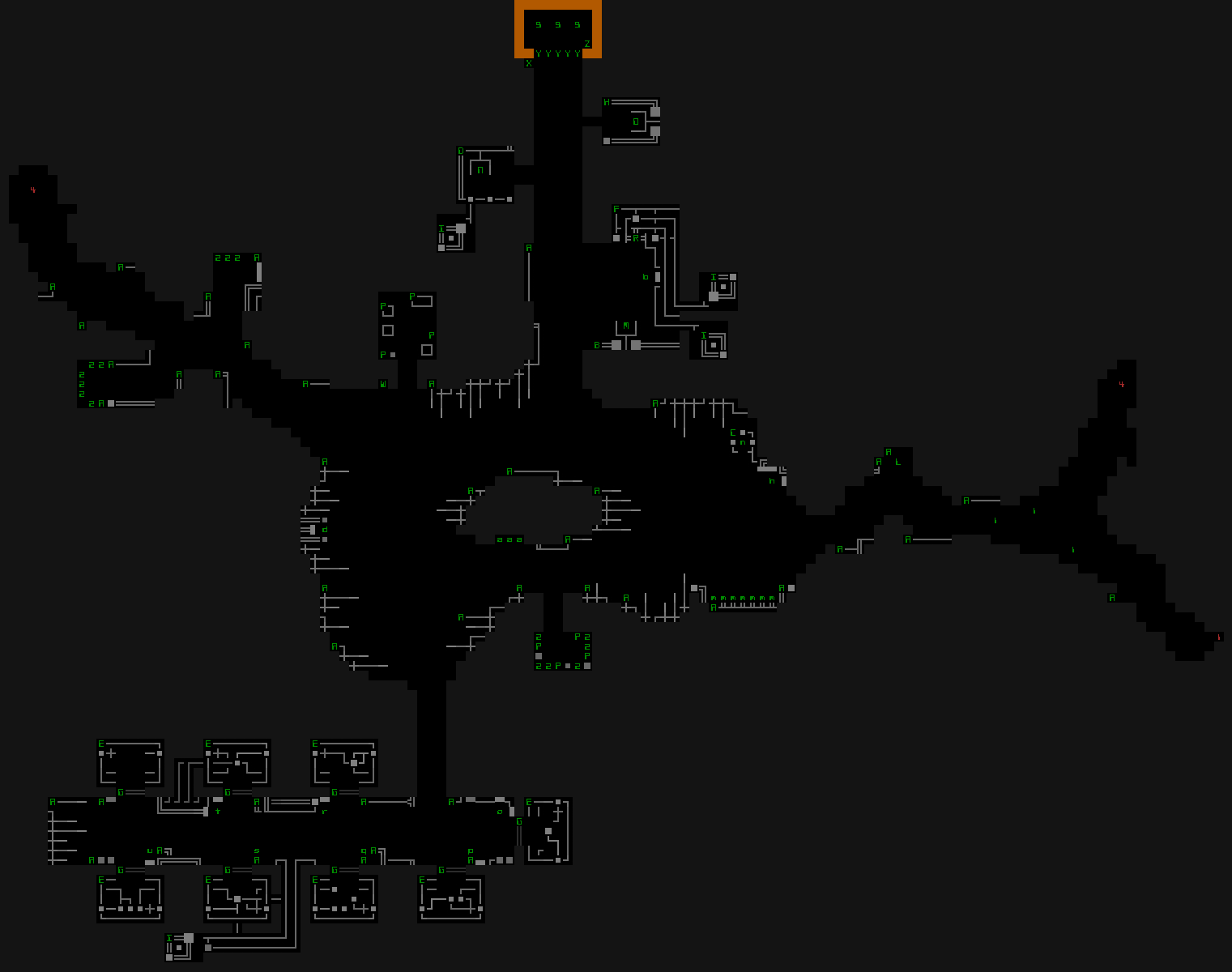
The corresponding data is written to a text file, the characteristics of which I described in the Map Prefabs article , in Depth .
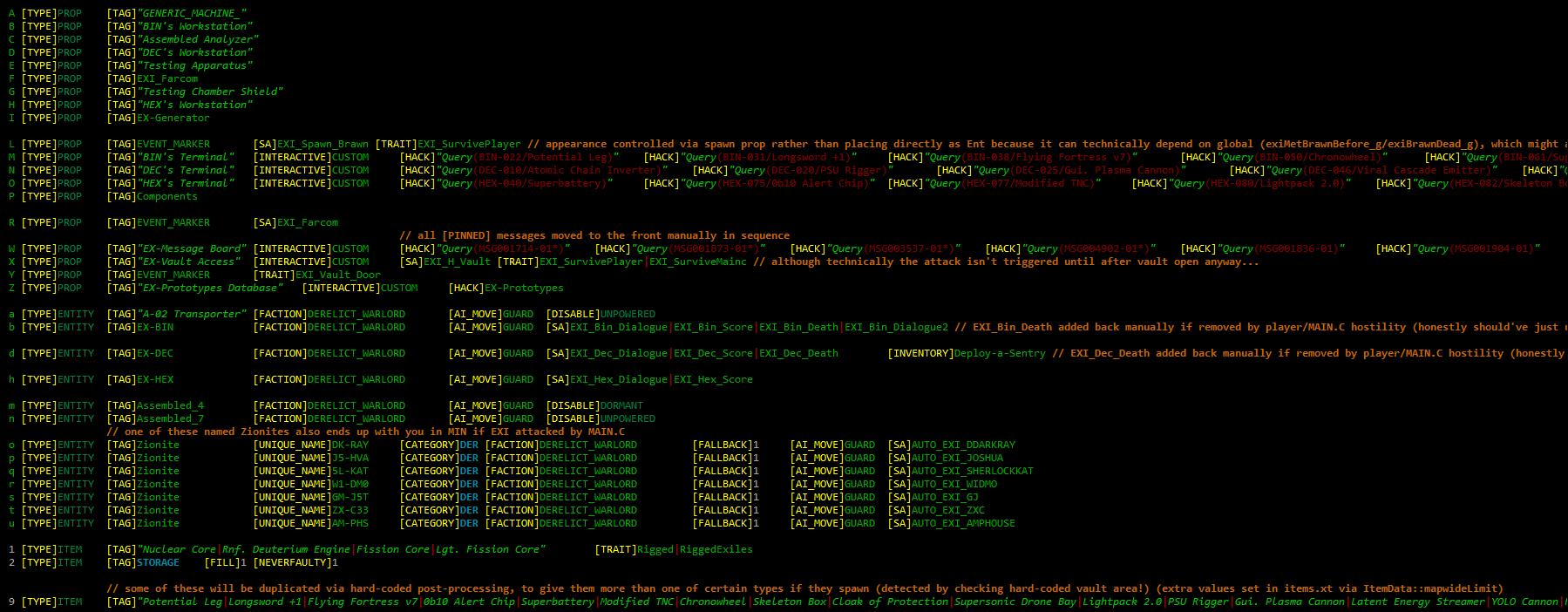
The finished workpiece Exiles in graphical form, because it is easier to read with the syntax highlighting enabled. (Some lines are very long, but because of them it was not worth expanding the images, so I just cut them off.) The file is also available in text form .
In the process of adding objects, I create a list of all the tests that are needed to confirm the correct operation of the content. I also constantly think about what can go wrong and what needs to be learned when everything is set in motion. This list will continue to be quite important, and therefore you need to write down each element, and not try to remember everything or start tests from scratch. Despite my efforts during the initial implementation, a lot of things usually go wrong, and it is definitely better to work everything out systematically, rather than wait for a wave of bug reports from users.
This is a fairly large map, so I did not wait until everything was placed on it, and began testing, conducting a series of tests and deleting list items in the process.
Embellishments
After finishing with the main content, I moved on to more superficial elements.
Mechanics FarCom I realized much earlier, but still there was no animation, which is to be played at the time of this ability of the Exiles. Cogmind has several full-screen animations that are reproduced when you get serious abilities, so FarCom should not be an exception.
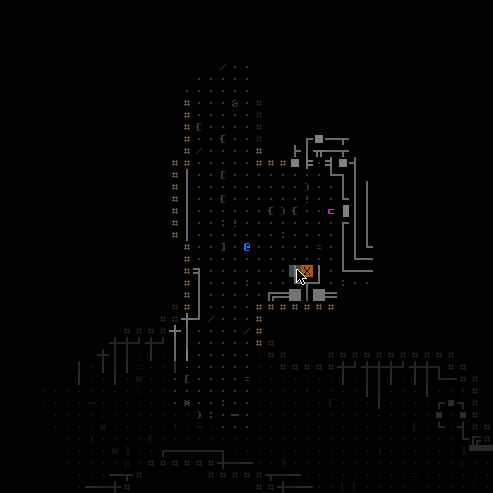
EX-BIN uses FarCom Aligner to add it to your system.
Another element that I always leave at the end of the content creation stage is sound. Working with sound effects forces you to focus not on the code, but on tasks, including managing a bunch of audio files and processing them in Audacity. It’s more efficient to work on them all at the same time, so when I get to something that requires a sound, I just leave a sound-stub and add this item to the list that I need to do after the rest of the content.

Visualization of the sounds surrounding the area around FarCom Aligner. Brightness means volume. If you want to read more about this, then I already wrote about the sounds of the environment .
There are other sounds that are not related to environmental sounds. They also need to do.
Options
I keep repeating that the Exiles card is "static", but that does not mean that there can be no small variations in it!
There is the usual variation created using the above described blank data: standard objects in storage rooms are randomized, as are prototypes (which have a rather large degree of variation, because objects can significantly change the gameplay, but in each passage they appear in different combinations) .
Also, variation is created due to the fact that a player may or may not encounter 8R-AWN before visiting Exiles; therefore, unique dialog options appear.
But the most significant variation is caused by the fact that players do not always find the map in its standard state. There are actually fourdifferent scenarios, and in the text above, only the first one is described. In the process of generating the world, the random state of the map is selected from the following options:
- 51%: standard script described above. This state is also always forcibly selected under various conditions of the world outside the map, so the true percentage is higher.
- 12%: devastated. Exiles have already cleared their terminals and left the lab.
- 12%: destroyed. Complex 0b10 has already attacked Exiles and the map has suffered in battle. There are no more survivors on it, but useful remains remain in the region.
- 25%: equivalent of the standard scenario, only 0b10 forces will attack while the player is on the map.
First, I created a base map, then implemented the 0b10 attack (in fact, this is an attached event), and then switched to two other options, because they were simpler. More complex map options should go first, because in order to work properly, they may require changing parts of the map. Therefore, if you leave difficult options for later, you will have to spend time remaking the previous work! It is difficult to predict in advance all the necessary changes, so this priority is important.
It was easy to create devastated and destroyed map options, because, in fact, these are changed data and REXPaint maps.

Harvesting the destroyed Exiles in REXPaint with all the data layers. A comparison with the previous standard scenario shows the presence of new destroyed machines, randomized (and randomly shifted) debris, exploded areas and other procedural content, such as robots, which can be used as spare parts.
The attack scenario demanded the most time because I had to watch the same battle over and over again to see all the possible results and see if they met expectations. I had to spend a couple of hours watching attacks, setting up various parameters repeatedly to get the results I needed.

Exiles attacked by complex 0b10. I turned on the display of the entire map for monitoring and debugging. 8R-AWN covers the flight, and the EX-DEC sets up a guard turret before leaving.
Features
Finally, almost everything is ready! At this stage, the “usual” way of passing is ready, but there is one more important stage: measures against cunning.
Naturally, some players will try to get any possible advantages, even if they require an obvious theft or killing of allies, so you need to balance these possibilities.
Note: not all roguelike are necessarily so balanced, some of them even amuse them with their complete imbalance , but Cogmind was mostly thought of as a very balanced gameplay. Even if some players succeed due to extreme agility to expand the boundaries, I want to be careful that certain actions always seem more rewarded than others, and the players see them as the “right way” to the goal and refuse all other possibilities.
Let Exiles be a friendly people, but players looking at them as a means to an end will try to finish off these robots. The solution to this problem was a bit more complicated than usual, because the Exiles gameplay is not limited to a single card - the hostile behavior of the players may begin when they have not yet seen 8R-AWN, so the behavior may change during the next meetings, including on the card itself .
Above, I cited a graph of strategic decisions that a player can make with regard to Exiles, and the whole reason for choosing these decisions is that each of them needs to pay its price. Players can choose from the following options:
1) Use the standard approach: take one prototype from the Exiles repository and use it and the FarCom scanning functions to help with the passage of the main areas of the Complex.
This is the easiest option, suitable for new players. They will lose the opportunity to "imprint" in Zion (usually this is another good help for beginners, but it is not available until the middle of the game), and in the later stages of the game they will have to avoid Research branches, which are deadly for FarCom players. From the point of view of balance, this is necessary because these branches contain alien technologies and some of the most powerful items in the game. FarCom simplifies the passage of many other maps, but at the cost of becoming inaccessible to these resources.
2) Take one prototype and FarCom, and still visit the branches of Research .
This is an extremely difficult option. Entering the Research branch with FarCom instantly launches the Maximum Security mode - the strongest Complex reaction, which is essentially an instantly switched on High Security version with even more attacks (in fact, endless waves entering the map of more and more difficult opponents). This mode was added to Cogmind specifically as a reaction to FarCom, but it made sense to include it in some other situations, so I used it in them.
In the rough notes about the design, you can see that initially the plan for countering FarCom for Branch Research was to release Tracker robots - a new kind of fast and deadly prototype bot. Later, I decided that Maximum Security would be the best solution here (mainly because it is even more intimidating), but having fully prepared the addition of Tracker robots, I decided to at least make them part of a redesigned system of intercept units.
Interception teams are another kind of compromise in Cogmind. Initially, he thought it was very difficult, but the players learned the strategy so well that it ceased to be difficult - now the good players are carefully considering whether they want to risk intercepting.
Ideally, the FarCom sensor mechanics and other building blocks, as fundamental as MaxSec and new interceptors, need to be asked in the early stages of the map design process, but until I came to a good solution, I had to temporarily leave everything as it is. In addition, I was impatient to release Exiles to Beta 8, so I had to postpone it and I did not make a decision until the final stage was completed. Some serious changes are better to wait.
3) Steal all three prototypes from the Exiles repository and increase the difficulty in the caves in the middle of the game.
Those who strongly want to assemble several prototypes can do it, even if they pay for it. Firstly, FarCom will stop working, because by stealing all the prototypes, you didn’t follow all their instructions; However, for some players it can be a positive event, because for them it will be possible to visit the branches of Research (and, if desired, “impressions”!).
Prototypes are quite powerful, so it is necessary that some kind of price be charged for their theft. For this option, I added a new hindrance: experienced thieves (Master Thieves). Although they are not found so often, thieves are hiding in Cogmind caves, so I created their own special look, which is even more effective and specially tracking the player-thief when he makes his way through the caves. If you steal from renegades, they steal from you - this is an eye for an eye deal. (Thieves rush headlong and try to tear the part away from their target, and then escape and disappear forever after disappearing from sight.)
After the release of Beta 8, some time has passed and, according to statistics, experienced players choose this route more often than others. I’m not sure if it will be necessary, but if such a route always provides an advantage, then it is worth thinking about other changes, for example, to allow experienced thieves to carry parts from the player’s inventory. However, I do not want to make this compromise as expensive as the link between FarCom and Research - it must be a choice that players will want to make in certain conditions.
4) Steal all three prototypes, but stick to only the main areas of the Complex, avoiding the caves.
Although it is not the easiest option, it is still easier than going through the Exiles. The theft of all prototypes means losing FarCom, but using sensors instead and avoiding caves means safety from thieves and at the same time the possibility of covert raids on Research branches to find the best parts. Avoiding caves does not mean that it is impossible to use the advantages of the middle stage of the game, but they are optional and there are still useful offshoots without caves that can be visited.
5) Kill Exiles, in particular, 8R-AWN, in order to pick up its superior configuration from prototypes, as well as steal all three prototypes.
In fact, this is the most powerful result for the player (assuming that he does not need FarCom), but at the same time the most dangerous option, because 8R-AWN is quite strong, and Cogmind is weak at the beginning of the game. However, players still choose this option.
I added the possibility of attacking Hero of Zion for all his hostile actions, but this attack is not guaranteed, so players can play in such a way as to realize the potential of their tricks. Better he attacks only in some cases, and it will be an unexpected event related to Lorus.
As you can see, there are quite a few features when adding a new card! We need to think about how the players will react to each of the possibilities, and whether they will consider the different compromises worth their price. When I make such decisions, it is very useful to play myself; besides, I always read about how the game is played by the players.
Source: https://habr.com/ru/post/452314/
All Articles